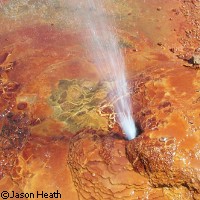CO2 in natural gas fields dissolves in water, study shows
An international study led by researchers in the UK has shown that in natural gas fields, which have stored carbon dioxide (CO2) and other greenhouse gases over millennia, most of the CO2 is stored by means of dissolving in water, rather than precipitating into minerals. Their findings, published in the journal Nature, have major implications for the study of the long-term effects of underground carbon storage. While concentrations of greenhouse gases in the atmosphere continue to increase, global political and public commitment to reducing the use of fossil fuels has not kept pace with the problem. A popular interim solution to reducing CO2 emissions entails capturing gas emitted from coal-fired power plants and storing it underground. However, little is known about the long-term safety or efficacy of such an approach. At best, engineering studies of CO2 in geological storage have offered an idea of what might happen over the course of decades. Meanwhile, computer models designed to simulate what might happen to CO2 injected underground have produced mixed results. In this latest research, the scientists used natural gas fields in China, Hungary and the US to study how CO2 has been stored naturally underground over the course of millennia; this offers a natural analogue for future carbon storage projects. 'We've turned the old technique of using computer models on its head and looked at natural carbon dioxide gas fields which have trapped carbon dioxide for a very long time,' said lead author Dr Stuart Gilfillan of the University of Manchester in the UK. The researchers used noble gas and carbon isotope tracers together to find out whether the CO2 was stored by means of being dissolved in water or being precipitated into carbonate minerals. Of the two options, mineral precipitation is preferable because in this way the carbon would essentially be 'locked up' for an extremely long time. 'By combining two techniques, we've been able to identify exactly where the carbon dioxide is being stored for the first time,' explained Dr Gilfillan. 'We already know that oil and gas have been stored safely in oil and gas fields over millions of years. Our study clearly shows that the carbon dioxide has been stored naturally and safely in underground water in these fields.' The researchers found that the amount of CO2 that precipitated into minerals was negligible compared to the 90% of the gas that was effectively removed by dissolving in water. Because of the danger for subsequent CO2 loss from the resulting 'sparkling' water (picture a cold bubbling geyser leaking the gas back out into the atmosphere), the researchers stress the need for carbon-storage researchers to look closely at the potential mobility of CO2 in water. The gas-tracing study also employed a novel research methodology. According to Professor Chris Ballentine of the University of Manchester, the Canadian and British partners brought expertise in different aspects of gas tracing to the project. 'By combining our expertise we have been able to invent a new way of looking at carbon dioxide fields. This new approach will also be essential for monitoring and tracing where carbon dioxide captured from coal-fired power stations goes when we inject it underground - this is critical for future safety verification.' In an accompanying commentary, Dr Werner Aeschbach-Hertig of the University of Heidelberg in Germany said: 'Although dissolution in groundwater implies the possibility of CO2 transport and eventual leakage to the atmosphere [...] as is thought to occur in natural gas fields, this result does not mean that safe geological storage is impossible. But it highlights the need for a thorough assessment of the hydrogeological setting of prospective storage sites.' The new methods offered by the researchers also provide a powerful tool for future research into the behaviour of geochemical trapping mechanisms. The findings represent a significant advance in understanding the long-term effects of capturing and storing greenhouse gases in geological repositories.
Countries
Canada, China, United Kingdom, United States



